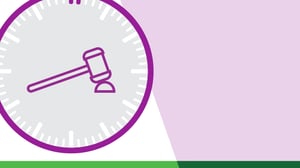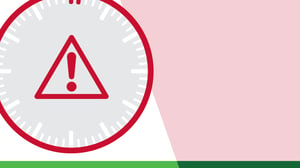

Our “2 Minutes: What’s the Risk?” video series features clinical, quality, and legal consultants discussing medical liability issues. The short format is ideal for sharing with staff at the opening to team meetings or other learning opportunities to provide a high-level view of common risk topics. View our video library below, or subscribe to the Risk Management YouTube channel to catch the ongoing series.

Risk management recommendations for communicating with patients and their families after an adverse event to help mitigate the risk of a potential claim or lawsuit.

High-alert medications include drugs such as insulin, heparin, chemotherapy agents, IV potassium, and opioids. These medications carry a greater risk of patient harm if used incorrectly or if an error occurs. Even a small mistake can have life-threatening consequences. This video provides risk management strategies to help prevent high-alert medication errors.

Event reporting is a systematic and timely internal process of reporting occurrences that deviate from expected outcomes. Adverse events include medical errors, near misses, and patient harm obtained as the result of the care delivering process. The benefit of event reporting is to foster a culture of patient safety and provide the opportunity for process improvement.

Telemedicine can be a valuable part of your practice, as it serves to enhance patient care through remote healthcare delivery, allowing providers to diagnose, treat, and follow up with patients without the need for in-person visits. It can also serve to enhance communication between providers and patients which can serve to ensure continuity of care and access to essential service

If you are involved in patient care, you likely have experienced workplace violence or you know someone who has. In this video we present some ideas on how to effectively handle workplace violence in a healthcare setting.

Patient termination is an unfortunate but sometimes necessary step when the relationship is no longer beneficial or safe. Following the guidance discussed will create firmer footing to move forward with this difficult decision.

ProAssurance recognizes communication as a critical aspect of a positive patient experience. Working to bridge the gaps across different languages and communities is a piece of that experience. We are excited to offer a 2-minute video to enhance patient communication at all levels of your clinical practices, in both English and Spanish. This valuable insight, presented by Lesley Lopez Viner, ProAssurance senior risk management consultant, can help build patient rapport, increase engagement and adherence to treatment plans, and lower medical liability risk.

ProAssurance reconoce que la comunicación es un aspecto fundamental para que la experiencia del paciente sea positiva. Superar las barreras linguisticas es una parte importante de esa experiencia. Nos complace ofrecerle un vídeo de 2 minutos, en inglés y en español, para mejorar la comunicación con el paciente en todos los aspectos de su práctica clínica. El video es presentado por Lesley Lopez Viner, consultora sénior de gestión de riesgos en ProAssurance. Ofrecerle una visita positiva al paciente puede generar confianza, promover la participación activa del paciente en su propio cuidado, y reducir el riesgo del litigio.

Handoffs occur all along the continuum of patient care between different members of the healthcare team. A successful handoff reporting process increases patient safety and may help decrease liability risk.
Author: Gerryann Whalen, Senior Risk Management Consultant

Patients with limited English proficiency can have adverse events that result in serious harm often caused by communication problems. These may lead to a lawsuit. Consider these strategies for mitigating these risks.

In this video we discuss the importance of responding to medical emergencies that arise in clinics and procedure areas outside the hospital and strategies to prepare for them.

The advent of electronic medical records (EMR) spawned a new service industry: medical scribes. Physicians and other providers were challenged by the EMR and its impact on the patient relationship since using this form of documentation can limit the amount of attention given to the patient. Though providers are becoming more comfortable with EMRs, they still may become distracted, causing patients to feel they’re not being heard, and may experience burnout. This video discusses how best to mitigate risks associated with using this type of service.

Locum tenens providers play an integral role in our healthcare system. They help ensure continuity in the delivery of care when providers are absent or on leave–but there are unique billing, coverage, and risk management issues that accompany utilization of these professionals.

Since patients started bringing their home video recorders into the hospital to record births and other medical procedures, video recording has created privacy concerns. As patients ubiquitously carry smartphones and have the capability to record everyday events, the likelihood of patients capturing other patients on video during a medical practice or hospital visit is all but certain. Healthcare systems must ensure the privacy of patient health information and prevent inadvertent disclosures to guard against HIPAA breaches.

Under HIPAA rules, a patient has the right to have an amendment added to their medical record for as long as the information is maintained within the designated record set. As a provider, you have the right to deny a patient’s request to amend the record if certain conditions exist.

Death certificates are important legal documents. They provide vital statistic data; documentation for burial or cremation services, estate settlement, and insurance or other benefits; and they often become evidence of cause of death in wrongful death lawsuits. For these and other reasons it’s important that they be as accurate as possible.

Generative AI has many potentially constructive applications in the healthcare space. Like adopting any other new technology in your practice, though, the benefits and risks of using generative AI in different contexts should be carefully analyzed before putting it to use.

All patients have the right to receive care in a safe setting and to have protection for their emotional health as well as their physical safety. The expectation of effective monitoring is to provide each patient with an optimal level of care. Ensuring sensitive supervision of the patients’ physical and psychological well-being. One-to-one supervision is a way to provide this care to patients at risk of causing harm to themselves or others.

In the era of rapid digital communication, text messaging has changed how healthcare providers communicate with each other and patients. However, physicians' use of text messaging can introduce significant risks and complications.

In our increasingly litigious society, medical professionals need to be well-versed in the civil litigation process. With that in mind, let’s talk about sitting for a deposition and what that entails.

Medical record documentation serves many functions. The primary purpose is to record the care you provide to patients and to communicate your plan of care to other providers involved in the patient's treatment.

As a provider, you may sometimes find yourself in the position of considering prescribing a drug for a use that is not FDA-approved, otherwise known as off-label use. In fact, one in five prescriptions is written for off-label use. However, it's important to understand that off-label use can come with complex considerations that require careful evaluation to ensure that it is the right choice for your patient.

Criticism in any form whether written or verbally expressed has the potential to lead to patient misunderstanding. When patients hear comments that suggest the mismanagement of a case, they begin to think the care received was substandard.

The goal of medical ethics is finding the most reasonable solution based on the totality of the circumstances. Aspects of patient safety, liability risk management, and clinical ethics overlap in that they involve scrutinizing problems occurring during a patient’s healthcare encounter. Improving the patient’s experience and well-being is a means for reducing overall risk.

Obtaining consent to treat a minor is a complex issue that requires a delicate balance between a minor's rights, parental rights, and ethical obligations of the healthcare provider. Information from U.S. Department of Health and Human Services, “Does the HIPAA Privacy Rule allow parents the right to see their children’s medical records?” was used in this video.

Informed consent is a fundamental ethical and legal requirement in healthcare, but beware of these common misconceptions about what it entails.

When referrals and diagnostic orders are made, the procedures must be air-tight to ensure accurate, relevant information is received, documented, reviewed, and acted upon.

Social media is a critical communication and promotional tool for most businesses and healthcare providers are no exception. However, there are many potential risks that healthcare professionals should be aware of when utilizing social media.

As a healthcare provider, you may receive a subpoena requesting the release of a patient's medical records. Understanding the legal obligations and procedures for responding to such subpoenas is an essential part of the modern practice of medicine.

Author of "When We Do Harm: A Doctor Confronts Medical Error," Dr. Danielle Ofri talks about the emotional impact of medical errors on caregivers and how to approach them among the care team.

In medical liability lawsuits, hospitals, medical groups, and other healthcare entities can be held directly liable for their own negligence in addition to any vicariously liability for their employee’s negligence. This 2 Minute video explains how proper documentation can help mitigate direct liability risk.

The lack of predictability and the potential long-term effects of a natural disaster can cripple an unprepared healthcare entity. Proper emergency management preparation and mitigation can vastly decrease vulnerabilities during a natural disaster. This video offers risk mitigation strategies to help your practice prepare.

Millions of Americans present to emergency departments with behavioral health complaints each year. In this video, we offer strategies that could improve outcomes for patients in psychiatric crisis and reduce the burden on hospital emergency departments.

There may be a number of reasons why a physician may be closing his or her practice. Whatever the reason, there are certain considerations for ensuring a smooth transition for patients. In this video, Mallory Earley, Southeast Regional Risk Manager, discusses some of those considerations. Learn about notifying patients and taking steps to safeguard patient records after the close of the practice.

While healthcare providers do not intend to cause harm, unexpected outcomes can occur. However, a regrettable result does not mean that there was negligence. Prompt and honest communication can have an impact on whether the unanticipated outcome will lead to a lawsuit.

The 21st Century CURES Act, enacted in 2016, established new federal regulations on a variety of healthcare concerns including funding, research, access to new and experimental drugs, telehealth, and interoperability of health information technology and introduces a new phrase to the healthcare community: information blocking.

Advance directives are legal documents created by a patient prior to healthcare treatment to record preferences regarding their care They are one of a number of areas where patients’ rights and healthcare operations intersect. In this video, Nichole Pieters discusses advance directives and the potential risk exposures posed by an organization’s failure to properly follow the documented wishes of a patient.

What happens when a patient shows up at your office or facility with a dog and claims that it is a service animal? Do you allow the animal in the waiting room with your other patients? Do you have the right to ask the patient why they require this animal? You soon find out that the dog is actually an emotional support animal. So now what? In this video, we review the difference between service animals and emotional support animals.

Often, physicians and staff must accomplish a patient task but cannot use the ideal method because the current work process has a flaw. Workarounds, or deviations from the standard process, are informal temporary workflows to accomplish a task that is perceived as dysfunctional. These alternative care deliveries may appear to function adequately, until an adverse event occurs or a patient experiences a near-miss.

The purpose of safety huddles is to not only provide a trusting forum for your staff to alert team members of unsafe situations, but to support colleagues who may be overwhelmed and need assistance.

Falls in healthcare facilities often result in patient injuries that lead to professional liability litigation for the healthcare provider. While it may not be possible to completely eliminate the risk of falls in your facility, you can implement strategies to improve your fall with injury rate.

Providing patients access to after-hours care requires careful consideration. In this video, Senior Risk Resource Advisor Laurette Salzman discusses the importance of a consistent process for response to after-hours calls for improving both patient satisfaction and outcomes.

Although some states specifically regulate the process for informed consent in telemedicine, there are a number of general factors a physician should consider when obtaining that consent, such as the nature of the patient’s condition, confidentiality, and the technological capabilities necessary.

The process of obtaining and documenting clinical staff competencies has evolved from a once per year checklist into an ongoing process of education and evaluation.

Increasingly, news stories feature allegations of inappropriate conduct lodged against individuals in a variety of professional settings. One way for a physician to guard against similar claims is by implementing a chaperone policy for all sensitive examinations.

Every professional arena includes individuals whose behavior falls short of generally accepted professional standards, and healthcare is not immune to this issue.

Compliance officer, business manager, human resource director, marketing chief: these are but a few of the roles assumed by the solo practitioner in addition to that of physician. What happens to the solo practitioner’s patients and practice when she is unexpectedly incapacitated?

Surgeons and operating room staff ask radiologists to assist in confirming or ruling out a retained surgical object by radiograph. In “Identifying Retained Surgical Objects,” Dr. Bob Stroud explains how his group created a glossary and digital file of commonly used surgical objects to help radiologists and surgeons at their hospital reduce the risk of retained surgical objects.

A successful medical practice strives for patient satisfaction, but patients may still complain about care received or some other aspect of a medical practice. In this video, Joanne Simmons, Senior Risk Resource Advisor for ProAssurance, offers suggestions for how a practice might generally respond to a patient complaint. With careful attention to the issue, good communication, and consideration for possible resolutions, you may reduce your risk exposure and possibly find patient satisfaction again.

Many ProAssurance policies, regardless of the state in which they are issued, contain a version of the Legal Defense Endorsement. This endorsement provides legal expense and audit expense coverage for what the endorsement defines as “covered investigations” and “covered audits.”

Many parents are refusing vaccinations for their children, and that issue is impacting pediatric practices—as well as other practices that treat pediatric patients. Because of this, many physicians are asking if they must allow unvaccinated children to be patients of the practice.

Setting clear plans, goals, and expectations from your first patient encounter is critical when caring for patients.

Patients may desire a social relationship beyond the boundaries of professionalism with their physician. However, minimizing personal distractions may result in a more effective professional physician-patient relationship.

Statistics show the question of whether a physician will be sued is “when” not “if.”

